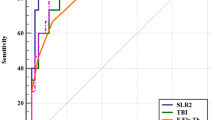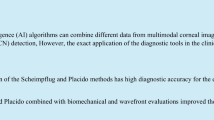Abstract
Purpose
To secondary statistical analysis of the Pentacam or Corvis ST parameters from literatures, and to obtain more sensitive diagnostic parameters for clinical keratoconus (CKC) and forme fruste keratoconus (FFKC), respectively.
Methods
The parameters and the corresponding area of ROC curve (AUC) in previous studies were extracted and screened to obtain the database of CKC (Data-CKC) and FFKC (Data-FFKC), respectively. Two different importance evaluation methods (%IncMSE and IncNodePurity) of random forest were used to preliminary select the important parameters. Then, based on the partial dependency analysis, the sensitive diagnostic parameters that had promotion to the diagnostic performance were obtained. Data-FFKC was analyzed in the same way. Finally, a diagnostic test meta-analysis on the sensitive parameter of interest was conducted to verify the reliability of the above analysis methods.
Results
There were 88 parameters with 766 records in Data-CKC, 57 parameters with 346 records in Data-FFKC. Based on two importance evaluation methods, 60 important parameters were obtained, of which 20 were further screened as sensitive parameters of keratoconus, and most of these parameters were related to the thinnest point of cornea. The stiffness parameter at first applanation (SPA1) was the only Corvis ST output parameter sensitive to FFKC except the Tomographic and Biomechanical Index and the Corvis Biomechanical Parameter (CBI). A total of 4 records were included in the meta-analysis of diagnostic tests on SPA1. The results showed that there was threshold effect, but no significant heterogeneity (I2 = 33%), and the area under the SROC curve was 0.87 (95% CI, 0.84–0.90).
Conclusions
For the diagnosis of FFKC, the sensitivity of SPA1 is not inferior to the well-known CBI, and may be the earliest Corvis ST output parameter to reflect the changes of corneal biomechanics during keratoconus progression. The elevation parameters based on the typical position of the thinnest point of corneal thickness are of great significance for the diagnosis of keratoconus.




Similar content being viewed by others
Availability of data and material
Data can be shared upon request.
Code availability
Code can be shared upon request.
References
Rabinowitz YS (1998) Keratoconus. Surv Ophthalmol 42:297–319
Huseynli S, Abdulaliyeva F (2018) Evaluation of scheimpflug tomography parameters in subclinical keratoconus, clinical keratoconus and normal caucasian eyes. Turk J Ophthalmol 48:99–108
Muftuoglu O, Ayar O, Ozulken K, Ozyol E, Akıncı A (2013) Posterior corneal elevation and back difference corneal elevation in diagnosing forme fruste keratoconus in the fellow eyes of unilateral keratoconus patients. J Cataract Refract Surg 39:1348–1357
Sedaghat MR, Momeni-Moghaddam H, Ambrósio R Jr et al (2018) Diagnostic ability of corneal shape and biomechanical parameters for detecting frank Keratoconus. Cornea 37:1025–1034
Kamiya K, Ishii R, Shimizu K, Igarashi A (2014) Evaluation of corneal elevation, pachymetry and keratometry in keratoconic eyes with respect to the stage of Amsler-Krumeich classification. Br J Ophthalmol 98:459–463
Elham R, Jafarzadehpur E, Hashemi H et al (2017) Keratoconus diagnosis using Corvis ST measured biomechanical parameters. J Curr Ophthalmol 29:175–181
Peña-García P, Peris-Martínez C, Abbouda A, Ruiz-Moreno JM (2016) Detection of subclinical keratoconus through non-contact tonometry and the use of discriminant biomechanical functions. J Biomech 49:353–363
Janitza S, Tutz G, Boulesteix A-L (2016) Random forest for ordinal responses: prediction and variable selection. Comput Stat Data Anal 96:57–73
Mun EY, Geng F (2019) Predicting post-experiment fatigue among healthy young adults: Random forest regression analysis. Psychol Test Assess Model 61:471–493
Hierowski MT, McDonald MW, Dunn L, Sullivan JW (1987) The partial dependency of human prostatic growth factor on steroid hormones in stimulating thymidine incorporation into DNA. J Urol 138:909–912
Song Z, Wang S, Liu Y (2018) The diagnostic accuracy of liquid exosomes for lung cancer detection: a meta-analysis. Onco Targets Ther 12:181–192
Huseynli S, Salgado-Borges J, Alio JL (2018) Comparative evaluation of Scheimpflug tomography parameters between thin non-keratoconic, subclinical keratoconic, and mild keratoconic corneas. Eur J Ophthalmol 28:521–534
Ambrósio R Jr, Caiado AL, Guerra FP et al (2011) Novel pachymetric parameters based on corneal tomography for diagnosing keratoconus. J Refract Surg 27:753–758
Vinciguerra R, Ambrósio R Jr, Elsheikh A et al (2016) Detection of Keratoconus With a New Biomechanical Index. J Refract Surg 32:803–810
Ambekar R, Toussaint KC Jr, Wagoner Johnson A (2011) The effect of keratoconus on the structural, mechanical, and optical properties of the cornea. J Mech Behav Biomed Mater 4:223–236
Acknowledgements
This study was fund by the National Natural Science Foundation of China (No. 32171304).
Funding
This work was financially supported by the National Natural Science Foundation of China (No. 32171304). The authors have no relevant financial or non-financial interest to disclose.
Author information
Authors and Affiliations
Contributions
ZH, ZX independently searched and screened in the literatures, extracted the available data from eligible studies. ZH completed the whole statistical analysis and produced the first draft of the manuscript. TL provided guidance for clinical ophthalmology knowledge. HL, LL helped supervise the project and gave suggestions on revision of article. Z-XX gave some suggestions on the method of data statistical analysis. Z-HX conceived the original idea and gave critical revision of article.
Corresponding author
Ethics declarations
Conflict of interest
The authors declare that they have no competing interest.
Ethics approval and consent to participate
Not applicable.
Consent for publication
Not applicable.
Consent for publication
All authors have agreed to the submission for the article.
Additional information
Publisher's Note
Springer Nature remains neutral with regard to jurisdictional claims in published maps and institutional affiliations.
Rights and permissions
About this article
Cite this article
Zhang, H., Zhang, X., Hua, L. et al. An exploratory analysis of forme fruste keratoconus sensitivity diagnostic parameters. Int Ophthalmol 42, 2473–2481 (2022). https://doi.org/10.1007/s10792-022-02246-0
Received:
Accepted:
Published:
Issue Date:
DOI: https://doi.org/10.1007/s10792-022-02246-0




